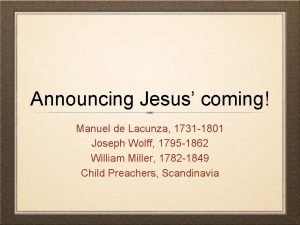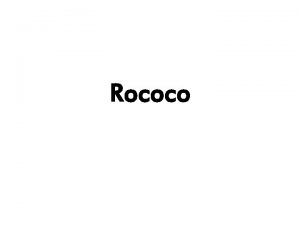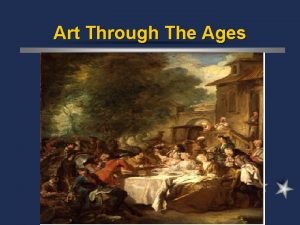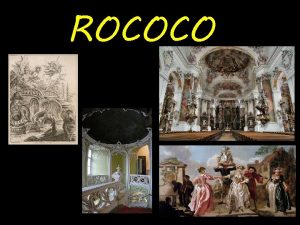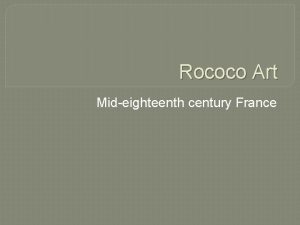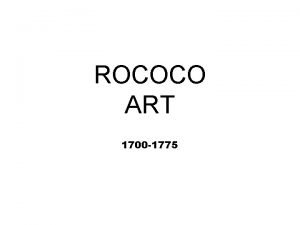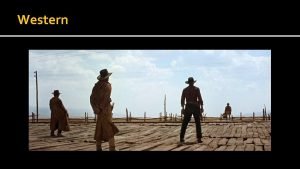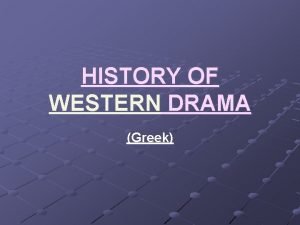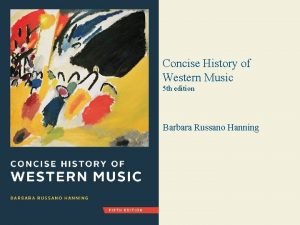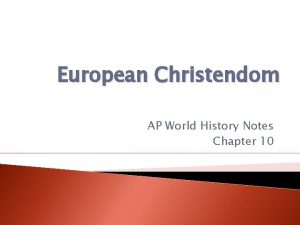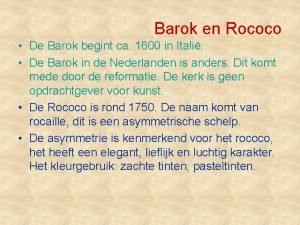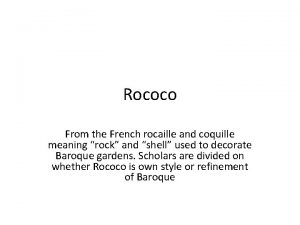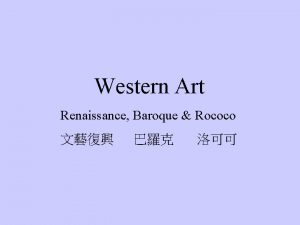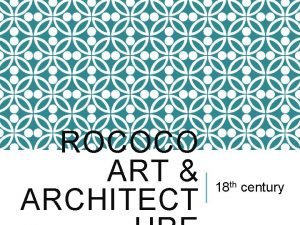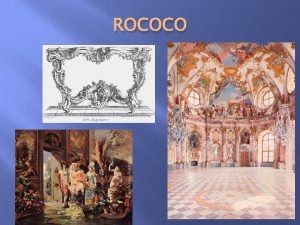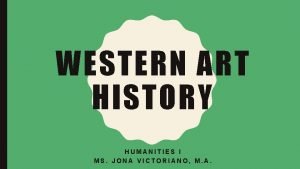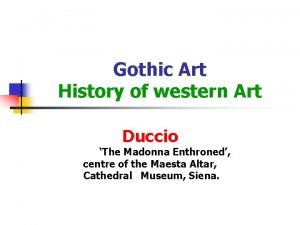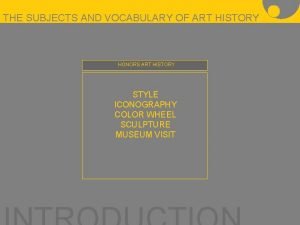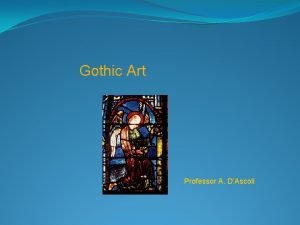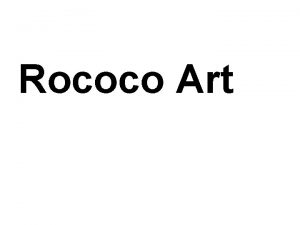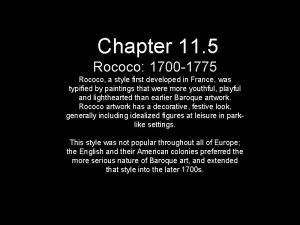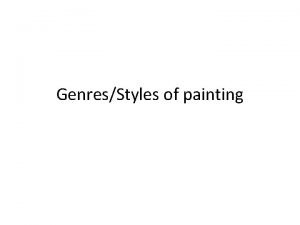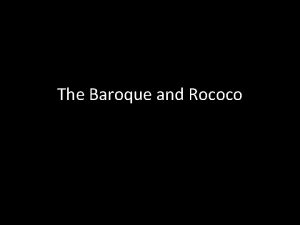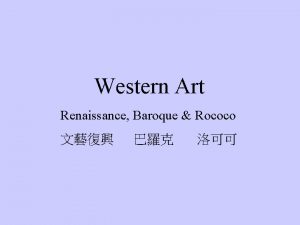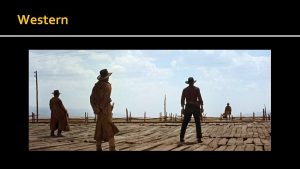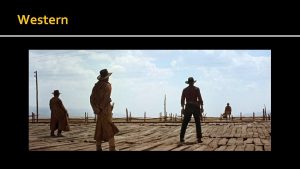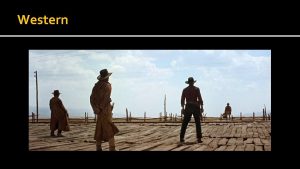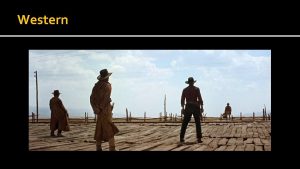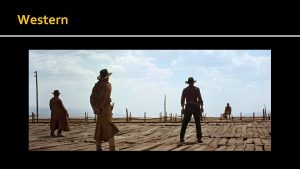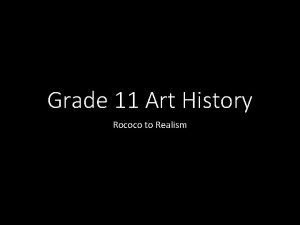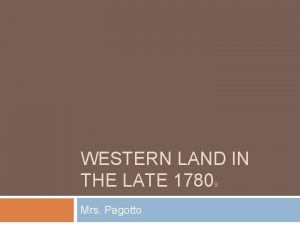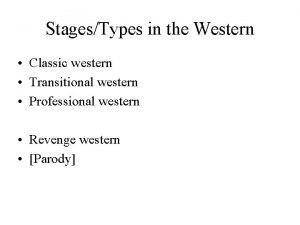ROCOCO ART 1702 1780 HISTORY OF WESTERN ART





























- Slides: 29

ROCOCO ART (1702 -1780) HISTORY OF WESTERN ART BFA-II (VISUAL ARTS) COURSE INCHARGE: FARAH KHAN INSTITUTE OF DESIGN & VISUAL ARTS (LCWU)

ROCOCO ART (1702 -1780) Rococo style originated in Paris in the early 18 th century primarily in interior design, the decorative arts, painting, architecture, and sculpture and was soon adopted throughout France and later in other countries, principally Germany and Austria. This style is characterized by lightness, elegance, and an exuberant use of curving natural forms in ornamentation. The word Rococo is derived from the French word rocaille, which denoted the shell-covered rock work that was used to decorate artificial grottoes. Rococo or Late Baroque, is an exceptionally ornamental and theatrical style of architecture, art and decoration which combines asymmetry, scrolling curves, gilding, white and pastel colors, sculpted molding, and trompe l'oeil frescoes to create surprise and the illusion of motion and drama. It is often described as the final expression of the Baroque movement.

ROCOCO ART (1702 -1780) In 1530 King Francis I, a noted art patron, invited the Italian artist Rosso Florentino to the French court, where, pioneering the courtly style of French Mannerism, Rosso founded the School of Fontainebleau (1528 -1630). The school became known for its unique interior design style in which all the elements created a highly choreographed unity. Rosso pioneered the use of large stucco reliefs as frames, adorned with decorative and gilded motifs that would heavily influence Rococo's emphasis on elaborated settings. Gilding was a key contribution of Fontainebleau, providing exquisite splendor to objects. At the beginning the Rococo style represented a reaction against the ponderous design of Louis XIV’s Palace of Versailles and the official Baroque art of his reign. Several interior designers, painters, and engravers, among them Pierre Le Pautre, J. A. Meissonier, Jean Berain, and Nicolas Pineau, developed a lighter and more intimate style of decoration for the new residences of nobles in Paris.

ROCOCO ART (1702 -1780) In the Rococo style, walls, ceilings, and moldings were decorated with delicate interlacing’s of curves and counter curves based on the fundamental shapes of the “C” and the “S”, as well as with shell forms and other natural shapes. Asymmetrical design was the rule. Light pastels, ivory white, and gold were the predominant colors, and Rococo decorators frequently used mirrors to enhance the sense of open space. Rococo painting in France began with the graceful, gently melancholic paintings of Antoine Watteau, culminated in the playful and sensuous nudes of Francois Boucher, and ended with the freely painted genre scenes of Jean-Honore Fragonard. French Rococo painting in general was characterized by easygoing, lighthearted treatments of mythological and courtship themes, rich and delicate brushwork, a relatively light tonal key, and sensuous coloring. Rococo sculpture was notable for its intimate scale, its naturalism, and its varied surface effects.

MAIN FEATURES OF ROCOCO ART (1702 -1780) In painting Rococo was primarily influenced by the Venetian School’s use of color, erotic subjects, and Arcadian landscapes, while the School of Fontainebleau was foundational to Rococo interior design. The noted painters Giorgione and Titian, among others, influenced the Rococo period’s emphasis on swirling color and erotic subject matter. Court culture was replaced by Salon culture. Themes of love, sensuality, playfulness, frivolousness were depicted. Figures were generally small and delicate It was associated mostly with decorative arts: pastel colors, irregular, curvilinear shapes, delicate lines and soft texture. Small scale works highlighted leisure activities of French aristocracy.

ANTOINE WATTEAU (French Painter) 1684 -1721 “In my view, you must either do away with ornament-or make ornament the essence. Its not something you add. Its not icing on a cake. Its everything-or nothing”

ANTOINE WATTEAU (1684 -1721) One of the most brilliant and original artists of the eighteenth century, Antoine Watteau (16841721) had an impact on the development of Rococo art in France and throughout Europe lasting well beyond his lifetime. Living only thirty-six years, and plagued by frequent illness, Watteau nonetheless rose from an obscure provincial background to achieve fame in the French capital during the Regency of the duc d’Orléans. His father was a roof tiler. According to early biographers his childhood was an unhappy one. As a boy he was sensitive and susceptible to quick changes of mood, a voracious reader of novels, and an avid music lover. He showed a penchant for making life studies of mountebanks performing on the public square, and his parents placed him in the workshop of a local painter.

ANTOINE WATTEAU (1684 -1721) At about the age of 18, Watteau decided to go to Paris, where he arrived penniless and apprenticed himself to an old painter, Metayer. Work was scarce, however, so young Watteau moved on to a position in a workshop specializing in votive paintings. Meanwhile, he made countless sketches from life, which were to be a source of thematic inspiration to him for the rest of his life. It was at this time that he made the acquaintance of the art dealers Jean and Pierre-Jean Mariette, in whose shop he admired a precious collection of drawings and engravings, including some by the etcher Jacques Callot. There, in about 1703, he also met his new teacher, Claude Gillot left strong influence of the practice of Watteau. Gillot was a decorator of theatrical scenery, with a great talent for painting grotesques, fauns, satyrs, and scenes d’opera. He detested the grandiose official art of his own time, preferring to work in the style of the 16 th-century school of Fontainebleau, with its free feminine grace. Gillot also painted subjects from the Italian commedia dell’arte, whose actors had been expelled from France only a few years before. Gillot’s taste for these subjects, as well as some features of his drawing style, are reflected in Watteau’s work.

ANTOINE WATTEAU (1684 -1721) He began to observe theatre from the wings: the makeup, the machines, the settings-all that serves to create scenic illusion. He discovered a new sense of light in the colorful reflections of artificial illumination on deep shadows, on made-up faces, on the brilliant costumes, and on the painted backdrops. in 1708, Watteau then entered the studio of Claude Audran III, one of the king’s leading painters and decorators. To say that Audran opened doors for Watteau is an understatement; his support, connections, and guidance were integral to the young artist’s career. In 1704, Audran was appointed conservator of the Palais du Luxembourg where Rubens’ cycle of canvases devoted to Marie de’ Medici were installed. Audran gave Watteau frequent access to study these works, and the Flemish master’s roiling color and energy profoundly informed his imagination. Equally, as Watteau progressed as a decorative painter, he learned to work quickly, developing a seemingly spontaneous sense of line and motif, which, in his later easel paintings, evolved into his distinctive flickering brushwork

ANTOINE WATTEAU (1684 -1721) In 1709 he was accepted as a student at the Académie Royale of painting and entered the competition for the Prix de Rome, but he failed to win the scholarship to Rome and decided to return to Valenciennes. His paintings feature figures in aristocratic and theatrical dress in lush imaginary landscapes. Their amorous and wistful encounters create a mood but do not employ narrative in the traditional sense. During Watteau’s lifetime, a new term, fete galante, was coined to describe them. Watteau was also a gifted draftsman whose sparkling chalk sheets capture subtle nuances of deportment and expression. Watteau’s elevation of ornament combined with his subtle compositions, use of color, and playful subjects captures the Rococo era like no other artist.

ANTOINE WATTEAU (1684 -1721) Watteau’s paintings of elegantly dressed aristocrats flirting in the landscape led the French Royal Academy to create a new genre to accommodate the painter: fête galantes. These pictures of courtship parties were concerned with themes of love, secrecy, playfulness, and wistfulness and combined genre painting with the mythological subjects so popular in history painting of the time. While Rococo art is known for its superficiality, high-living, and light-heartedness, Watteau’s compositions were indebted to close observation of nature and life, which he initially rendered in countless drawings that later informed his paintings. Perhaps not so neatly delineated as they are now, both decorative and fine arts were part of Watteau’s repertoire. Painting on panels or directly on the wall, Watteau created motifs and vignettes to decorate dining rooms and studies of his patrons, and he created large oil paintings that were accepted by the French Royal Academy. Often, the subject matter of both modes of work coincided in scenes of musicians, lovers, and lush landscapes.

ANTOINE WATTEAU (1684 -1721) Many of Watteau’s most important works have a stage-like setting, with the panoramic scene extending laterally in very shallow space. Such compositional devices can be traced to his love of theater and ballet. Both opera and the more popular Commedia dell’arte, were his favorite subjects. Women reign in his paintings. Men—cavaliers or clowns—are there to please the women who glide by, enfolded in their splendid silken attire's. The statues in the parks are almost always statues of women. And even nature is feminine: trees with slender trunks, rich with a soft and uncertain foliage. In his own words: “I create the painting in my mind, color gives me inspiration, passion is very important, so I am looking for radiance, with all my soul”

SELF PORTRAIT

PLEASURE OF LOVE

THE DANCE

THE LOVE LESSON

THE FEAST OF LOVE

LA SURPRISE

FEAST IN VENICE

FAIR AT BEZON

MUSICIAN

THE PILGRIMAGE TO CYTHERA

THE FRENCH COMEDIANS

PIERROT

THE ITALIAN COMEDIANS

HEAD OF A MAN

STUDY OF A WOMAN’S HEAD AND HANDS

SEATED WOMAN

STUDIES OF A WOMAN PLAYING
 May 19, 1780
May 19, 1780 May 19, 1780
May 19, 1780 Against the gods 1780
Against the gods 1780 Rococo painting characteristics
Rococo painting characteristics Rococo art characteristics
Rococo art characteristics Definition of rococo
Definition of rococo Most famous rococo paintings
Most famous rococo paintings The rococo art movement was born out of
The rococo art movement was born out of Rococo art
Rococo art Western subgenres
Western subgenres History of western drama
History of western drama Concise history of western music 5th edition
Concise history of western music 5th edition Chapter 10 the worlds of christendom notes
Chapter 10 the worlds of christendom notes Origin of western theatre
Origin of western theatre History of western theatre
History of western theatre What is typography art
What is typography art Middle ages floral arrangements
Middle ages floral arrangements Kenmerken rococo
Kenmerken rococo Coquille rococo
Coquille rococo Floral design timeline
Floral design timeline Arte rococo en españa
Arte rococo en españa Rococo 黃藍
Rococo 黃藍 Rococo characteristics
Rococo characteristics Stilul rococo
Stilul rococo What is western art
What is western art Western gothic art
Western gothic art Also history physical
Also history physical Art history vocabulary
Art history vocabulary Gothic architecture characteristics
Gothic architecture characteristics Early christian art characteristics
Early christian art characteristics

